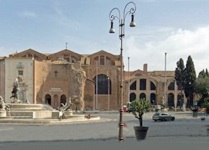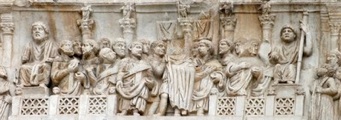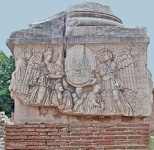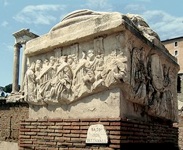Baths of Diocletian (ca. 298-305 AD)
Despite the traditional pre-eminence that Rome enjoyed within the Empire, neither Diocletian nor Maximian ever established an imperial residence there. As set out in the page on Diocletian’s Rise to Power, Diocletian made a ceremonial entrance into Milan after his victory over Carinus in 285 AD, and it is possible that he continued to Rome in order to receive ratification by the Senate. However, if so, this visit can only have been a brief one, because he was documented in Pannonia on 2nd November 285 AD. He established his first imperial residence at Sirmium at this time, from whence he campaigned against the Samartians on Danube frontier.
Before his departure for the Danube, Diocletian had appointed Maximian as Caesar, with responsibility for the suppression of the rebellion of the Bagaudae in Gaul. Maximian consequently established his main residence at Treviri (Trier), the city that had been the capital of the independent Gallic Empire in 260-74 AD. He remained there after his appointment as Augustus in 286 AD, in order to deal with the subsequent rebellion of Carausius and the secession of Britain.
As Augustus, Maximian had formal responsibility for the western part of the Empire, which of course included Rome. His failure to even visit the city must therefore have aroused comment. For example, in a panegyric (Panegyric X, translated into English in Nixon and Rodgers, referenced below) that was delivered in Trier in 289 AD on the anniversary of the foundation of Rome, the panegyrist observed:
-
“... since state business keeps this most longed-for ruler [Maximian] in his Gallic realms, we beseech you [Rome] ... that you not be jealous of this city [Trier], upon which [Maximian] now confers a majesty similar to your own by celebrating your birthday [here]” (14: 3).
This seems to have been a rather smug reminder that ‘Rome’ was where the Emperor was. Slightly earlier, the panegyrist had commented on the sense of loss that he imagined (probably correctly) that the Romans felt because of Maximian’s absence during this most important of the city’s annual celebrations:
-
“O Emperor, how much more majestic [Rome] would be now, how much better would she celebrate this her birthday, if she were viewing you [in the flesh]. Now, doubtless, her citizens are imagining that you are present by flocking to the temples to your divinities [i.e. to the patron deities of Diocletian and Maximian] and, following the practice instituted by our ancestors, by repeatedly invoking Jupiter Stator and Hercules Victor” (13:4).
It is possible that, despite Maximian’s absence from the city, his wife, Eutropia, had a home there. This is suggested in a much later panegyric that the future Emperor Julian presented to his cousin, then the Emperor Constantius II, in 335 AD, in which he spoke of the birth (in ca. 289 AD) and early upbringing of Maximian’s youngest child, Fausta, who was Constantius’ then-deceased mother:
-
“[Rome] gave your mother birth, rearing her royally and as befitted the offspring who were to be born to her” (“Panegyric in Honour of Constantius II”, 5).
The panegyrist of 289 AD expected that Rome’s desolation would be temporary, and that both Maximian and Diocletian would surely reside there once they had secured the boundaries of the Empire:
-
“And you [Maximian], we beseech that even when you have re-established the security of the whole world and when [Rome] has received you, you will loosen from time to time .. her clinging embrace [and return to Trier/Gaul] ... I believe that the [cities of the eastern part of the Empire] make this very same request of Diocletian” (14: 3-4).
However, neither Diocletian nor Maximian showed any particular desire even to visit the city. Thus, when they crossed the Alps from opposite directions for their meeting of 290 AD, they travelled only as far as Milan, and the Senate was obliged to send representatives to meet them there. In Panegyric XI (translated into English in Nixon and Rodgers, referenced below), which was delivered at Maximian’s court, probably at Trier and probably in 291 AD, the panegyrist exclaimed:
-
“Even Rome herself ... sent the luminaries of her own Senate, gladly sharing with Milan ... the semblance of her own majesty, that the seat of imperial power could then appear to be the place to which each Emperor had come” (12:2).
One wonders how gladly Rome really did share her majesty with Milan and the other imperial capitals.
When Constantius was appointed as Maximian’s Caesar in 293 AD, he assumed responsibility for the suppression of Carausius and for the security of Gaul. He therefore took over the imperial residence at Trier. However, Maximian did not now move to Rome (as the panegyrist above had expected). Instead, he chose Milan as his principal residence.
Imperial Representatives in Rome
Given this imperial absence from Rome, the Augusti presumably relied on senior allies in the Senate to maintain their prestige in the city, a service that was probably rewarded with a Consulship and/or a period as Urban Prefect. In the page on Diocletian and Maximian in 285-93 AD, I set out the evidence for the hypothesis that Lucius Caesonius Ovinius Manlius Rufinianus Bassus was probably the first of these allies: he served his second Consulship with Diocletian for the last weeks of 284 AD, and probably became Prefect of Rome early in the following year. In that case, he would naturally have been present when Diocletian made his ceremonial entrance to Milan (above).
Titus Claudius Aurelius Aristobulus was another survivor from the previous régime, and he also probably facilitated imperial relations with the Senate. He had been Carinus’ Praetorian Prefect at the time of his murder in 285 AD, and had also held the Consulship with Carinus in that year. He went on to hold the Consulship again, this time with Diocletian, in the following year. He then served as Proconsul of Africa in 290-4 AD, which was another prestigious Senatorial appointment. (Later in the reign, in 295-6 AD to be precise, he served as Urban Prefect).
Three other men who held the post of Urban Prefect in the period of the Dyarchy and who were also rewarded with the Consulship were:
-
✴Marcus Junius Maximus: Urban Prefect in 286-8 AD, Consul of 286 AD;
-
✴Pomponius Januarianus, who had served in the previous régime as Prefect of Egypt: Urban Prefect in 288-9 AD, Consul of 288 AD, with Maximian; and
-
✴Gaius Junius Tiberianus, a distinguished soldier who who had already held a Consulship in 281 AD: Urban Prefect in 291-2 AD, Consul of 291 AD.
Nevertheless, later events would prove that alliances like these could not be relied upon in perpetuity to satisfy the aspirations of the Senate and the people of Rome.
Veneration of the Tetrarchs in Rome
Since the Tetrarchs were rarely seen in Rome, the maintenance of their ‘virtual presence’ in the city must have been of particular importance. A reference in a panegyric (Panegyric X, translated into English in Nixon and Rodgers, referenced below), which was delivered at the court of Maximian at Trier in 289 AD to mark the anniversary of the foundation of Rome, indicates an important way in which this was achieved: the panegyrist beseeched Maximian:
-
“O Emperor, how much more majestic [Rome] would be now, how much better would she celebrate this her birthday, if she were viewing you [in the flesh]. Now, doubtless, her citizens are imagining that you are present by flocking to the temples to your divinities and, following the practice instituted by our ancestors, by repeatedly invoking Jupiter Stator and Hercules Victor” (13:4).
Commenting on this passage, Elizabeth Marlowe (2010, referenced below) drew particular attention to:
-
“... the fact that Jupiter and Hercules are honoured as the Tetrarchic comites [literally ‘companions’, but in this context ‘divine patrons’]:
-
-not in their generic or universal guises; but
-
-in the very particular form of their metropolitan Roman cults, Jupiter Stator and Hercules Victor”.
The translator of the panegyric, by referencing the temples of Jupiter Stator and Hercules Invictus in Rome (at p. 74, note 38), implied (surely correctly) that these were “the temples to your divinities” in which (according to the panegyrist) the Romans experienced the virtual presence of the Augusti, presumably by venerating the imperial images that these temples contained. The possible reason why these particular temples served this function are discussed in the page on Imperial Cult (285-305 AD).
Maximian’s First Visit to Rome (298-9 AD?)
A remark in Panegyric VII (translated into English in Nixon and Rodgers, referenced below), which was delivered at Constantine’s court during a famous visit by Maximian (newly emerged from retirement) in 307 AD, the panegyrist remembered that:
-
“Upon your first entry [into their city], the Roman people greeted you [Maximian] with such joy and in such great numbers that ... they scarcely allowed you through the gates of the city, such was the press” (8:7).
The translator (at note 32) pointed out that the previous paragraph of the speech had dealt with Maximian’s victories in Africa in 296-8 AD, and that he probably made this momentous visit to Rome immediately thereafter. The inscriptions (CIL VI 1130) from the Baths of Diocletian (below) indeed confirm that Maximian commissioned this massive complex “on his return from Africa”. Maximian issued a rescript (Frag. Vat. 41) from Carthage on 10th March 298 AD, but the length of his stay in that city is unknown. C.E. V. Nixon (referenced below, at note 10) suggested that he had probably arrived in Rome in time to celebrate the start of his sixth Consular year, 299 AD.
Imperial Vicennalia (November 303 AD)
In November 303 Diocletian visited Rome for probably the first time to mark his vicennalia, the 20th anniversary of his accession. As explained in the page on the First Tetrarchy, Maximian’s official date of accession had been altered in 293 AD so that it coincided with that of Diocletian. Maximian therefore shared in the celebration. This was an almost unprecedented event: no Emperor had ruled long enough to celebrate his 20th anniversary since Antoninus Pius (138-61 AD). The city also celebrated the 10th year of the rule of the Caesars, which had begun on 1st March 303 AD, although neither Constantius nor Galerius was present.
The sources make it clear that Diocletian used this occasion to celebrate a formal triumph for the many victories that the imperial colleagues had achieved in the previous decade.
-
✴According to Eutropius, before their abdication (below) and thus surely on this occasion:
-
“... [Diocletian and Maximian celebrated] a magnificent triumph ... at Rome over several nations, with a noble procession ... in which [pictures of the captured and subsequently released] wives, sisters,and children of Narseus were led before [the Emperors’] chariots” (‘Breviarium historiae Romanae’, 27:4).
-
✴According the so-called ‘Chronogaph of 354 AD’:
-
“ [Diocletian and Maximian] scattered gold and silver coins in the circus. [Presumably on this occasion], the wall that formed the base of the seating for the boxes in the circus collapsed and crushed 13,000 people; and a woman named Irene gave birth to three boys and a girl. [The Emperors] placed [representations of] the king of the Persians with [similar representations of the leaders of other defeated] nations and their tunics of pearl, in number 32, around the temples. They brought 13 elephants, 6 drivers and 250 horsemen into the city”.
(These two sources suggest that important royal prisoners (including, in the second case, Narses himself) had been exhibited during this triumph, but I have amended this in square brackets, following the deductions of C. E. V. Nixon (referenced below, 1981, at p 75).
It seems that Diocletian had initially planned to stay in Rome long enough to celebrate the start of the year of his 9th Consulship there, but that he subsequently changed his mind. According to Lactantius:
-
“... suddenly [Diocletian], unable to bear the Roman freedom of speech, peevishly and impatiently burst away from the city. The kalends of January [i.e. the start of the following year] approached, at which day the Consulship, for the 9th time, was to be offered to him: yet, rather than continue 13 days longer in Rome, he chose that his first appearance as Consul should be at Ravenna. ” (‘De Mortibus Persecutorum’ 17:2-3).
The Romans would never see him in their city again.
In Panegyric VIII (above), the panegyrist claimed (possibly for reasons of rhetoric rather than accuracy) that:
-
“... when you [Maximian] were in your 20th year as Emperor and Consul for the eighth time, Rome herself so wished to detain you in its embrace ... that she seemed already to have a presentiment and fear of what actually happened. For what happened, eternal Emperor, was the one deed by which you almost earned the complaints of the State” (8: 8-9).
This suggests that Maximian remained in Rome after Diocletian’s departure and that he was still there on 1st January 304 AD, when his 8th (and Diocletian’s 9th) Consular year began. The Roman’s dreaded premonition was of an event that occurred in the following year: Maximian, together with Diocletian, abdicated. This would have “earned the complaints of the State” had he not (as we shall see) renounced his abdication and returned to Rome in 307 AD.
Public Works in Rome
Adlocutio Frieze, Arch of Constantine (315 AD)
Scene set against the backdrop of the Vicenellian Monument in the Forum Romanum
According to the so-called ‘Chronogaph of 354 AD’, much of the Forum Romanum, which had been devastated by fire in the reign of Carinus, had been substantially rebuilt in the riegn of Diocletian and Maximian:
-
-“While [Carinus and Numerian] were ruling, there was a great famine [in Rome] and public buildings burned down: the Senate; the Forum of Caesar; the Basilica Julia and the Graecostadium”.
-
-“While [Diocletian and Maximian] were ruling, many public works were built [or rebuilt in Rome]: the Senate House; the Forum of Caesar; the Basilica Julia; the stage of the Theatre of Pompey; two porticos; three nymphaea; two temples, [including ??] the temple of Isis and Serapis; the Arcus Novus [the now-lost Arch of Diocletian on Via Lata, described as LSA-2670 in the database ‘Last Statues of Antiquity’], and the Baths of Diocletian”.
Elizabeth Marlowe (referenced below, 2015, at pp. 13-4) doubted that the Tetrarchs’ building activity in Rome was as extensive as often claimed. She acknowledged the existent of Tetrarchic brick stamps on a number of structures in Rome (which included: the Curia; the Forum of Caesar; the Basilica Argentaria; the Basilica Iulia; and the Baths of Diocletian). However, she pointed out that:
-
“Aside from the Baths [of Diocletian], whose imperial patronage is attested by a dedicatory inscription, ... I see little reason to give credit for all of these projects, most of which amount to repairs after the devastating fire of 283, to [the Tetrarchs]. The [brick] stamps cannot be used to differentiate among various possible patrons at a particular moment in time. Surely buildings sponsored by the Senate (or by Maxentius, following his usurpation in 306 AD, or by Constantine, after 312 AD) would have made use of bricks from the same brickyards that had produced for the [Baths of Diocletian]. Contrary to the scholarly view of these rulers as good old-fashioned benefactors of the ancient capital, the Tetrarchs showed little interest in Rome. With their new imperial capitals at the four corners of the Empire, they were the first Roman rulers to turn their backs openly on the urbs. The irony of Diocletian’s 303 celebrations for his vicennalia is that it made all the more noticeable the fact that he’d been in power for twenty years without ever setting foot in the capital until now”.
Baths of Diocletian (ca. 298-305 AD)
The inscriptions (CIL VI 1130) from the baths of Diocletian (mentioned above) confirm that Maximian commissioned this massive complex on his return from Africa (in 298 AD), and that it was completed and consecrated at some time after the 1st May 305 AD (the date of the abdication of Diocletian and Maximian, who are thus described as the senior or retired Augusti) and the 25th July 306 AD, the date of the death of Constantius:
DD(omini) nn(ostri) Diocletianus et [[Maximianus]] Invicti
Seniores Augg(usti) patres Impp(eratorum) et Caess(arum) et
dd(omini) nn(ostri) Constantius et Maximianus Invicti Augg(usti) et
[[Severus et]] Maximinus nobilissimi Caesares
thermas Felices [Dio]cletianas quas
[M]aximianus Aug(ustus) re[dien]s ex Africa
sub [pr]aesentia maie[state] disposuit ac / [f]ieri iussit et
Diocletiani Aug(usti) fratris sui nomine consecravit coemptis aedificiis
pro tanti operis magnitudine omni cultu perfectas Romanis suis dedicaverunt
Our Lords Diocletian and Maximian, the senior and invincible Augusti
fathers of the Emperors and Caesars
our lords Constantius and Maximian, invincible Augusti and
Severus and Maximin, most noble Caesars
dedicated to their beloved Romans these auspicious Baths of Diocletian
which Maximian, on his return from Africa, ordered to be built and
consecrated in the name of his brother Diocletian
having purchased the premises required for so huge and remarkable work
and furnishing them with the most sumptuous refinement
Five Columned Monument (ca. 303 AD)
The frieze on the Arch of Constantine that is illustrated above depicts Constantine giving a speech from the Rostra in the Forum Romanum in 312 AD, with a five-columned monument behind him. Elizabeth Marlowe (referenced below, 2015) began her analysis of this monument with a summary of the work of Hans Peter L’Orange (also referenced below), who first identified this as a five-columned monument that had been erected in the Forum Romanum to form a backdrop to events that took place during the Vicennalia celebrations.
Two faces of the surviving pedestal from the Decennalian Monument
Much of his work of deduction had been based on the evidence of extant pedestal for one of the granite columns from the monument, the four faces of which depicted (respectively):
-
✴two Victories inscribing a shield with the words CAESARUM DECENNALIA FELICITER (‘To the tenth anniversary of the Caesars, joyously’; CIL VI 1203 );
-
✴a procession;
-
✴a lustration; and
-
✴the animals and officials associated with a type of sacrifice called a suovetaurilia, a word formed from the names of three animals, the pig (sus), sheep (ovis) and bull (taurus)
L’ Orange connected the monument with records of other (lost) inscriptions commemorating:
-
✴the AUGUSTORUM VICENNALIA FELICITER; and the
-
✴VICENNALIA IMPERATORUM.
He also identified the statues depicted on the columns in the relief on the Arch of Constantine as those of Jupiter (at the centre) flanked by the Tetrarchs.
As Elizabeth Marlowe explained, excavations in ca. 1980 revealed that this five-columned monument had been part of a larger project:
-
✴a matching five-columned monument had also been built at this time at the opposite end of the Forum, in front of the Temple of Divus Iulius; and
-
✴seven more free-standing columns had been erected in front of the Basilica Iulia to the south.
Thus, it seemed that the central area of the forum had been enclosed on three sides by columnar screens at about this time.
Elizabeth Marlowe (as above) reflected on:
-
“... the possibility that the 17-column structure ... was actually built in stages. It is, in fact, very hard to make sense of the seven-column leg in light of the Tetrarchic imagery and ideology of 303 AD. Identities for the five statues atop the two five-column segments spring readily to mind:
-
-as we have seen, Jupiter, plus the four [Tetrarchs];
-
-or perhaps ... Jupiter at the centre of one colonnade and Hercules on the other.
-
But who could have been featured atop two additional columns at the moment of the celebration of the vicennalia? No obvious candidates come to mind. It seems more likely to me that [either]:
-
-the monument built in 303 AD comprised three legs of 5 columns each, and that two additional columns were added to the southern leg later; or (even more plausibly)
-
-the original monument consisted only of the two 5-column segments on the eastern and western Rostra, [while] the entire third [southern] leg was added at a later date”.
Read more:
E. Marlowe, “The Multivalence of Memory: the Tetrarchs, the Senate, and the Vicennalia Monument in the Roman Forum”, in:
K. Galinsky and K. Lapatin, (Eds.), “Cultural Memories in the Roman Empire”, (forthcoming in 2015), Getty Museum Press
I am extremely grateful to Dr Marlowe for sending me an advance copy of this paper.
E. Marlowe, “Liberator Urbis Suae: Constantine and the Ghost of Maxentius” in
B. C. Ewald and C. F. Noreňa (eds.) “The Emperor and Rome: Space, Representation and Ritual’ (2010) Yale
C. E. V. Nixon, “The Panegyric of 307 and Maximian's Visits to Rome”, Phoenix 35 (1981) 70–6
H. L’ Orange, “Ein Tetrarchisches Ehrendenkmal auf dem Forum Romanum”, Mitteilungen des Deutschen Archäologischen Institut (Römische), 53 (1938) 1-38
Diocletian (284-305 AD):
Diocletian's Rise to Power (284-5 AD) Diocletian and Maximian (285-93 AD)
First Tetrarchy (293-305 AD) Diocletian, Maximian and Rome (285-305 AD)
Military Campaigns: Maximian and Constantius in the West (293-305 AD)
Military Campaigns: Diocletian and Galerius in the East (293-305 AD)
Imperial Cult (285-305 AD)
Diocletian to Constantine (285-337 AD): Literary Sources
Return to the History Index







